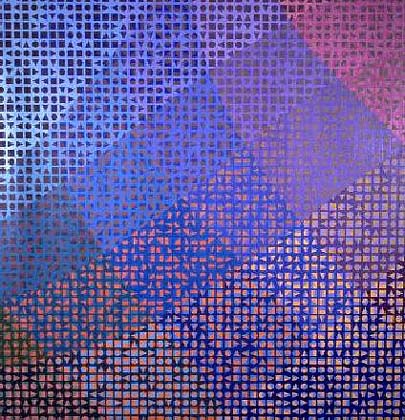|

|
135.
Title: Random Study One
Media: Acrylic painting on linen stretched on Masonite
Size: 48 in. x 48 in.
Original's Price: $3,700
Original Available (y/n): [Yes]
Available Format(s): Original Piece, Matted Prints, Note Cards
Price(s): $3,700, $85, $5.25 ea respectively
Year of Completion: 2000
Catalog No.: 00G15-1
Purchase Information:
Contact the artist
|
Random Study One took three years to complete. It was not a continuous task
simply because of the technical detail involved. It is the only painting that
DID involve a computer, but only in a very indirect way. I wrote a program in
the Basic language which generated random numbers from 1 through 12. I was
curious if it would be possible to paint something that was 100% random. The
OUTPUT from my program came out onto an 8 1/2" x 11" piece of paper. I wrote
the program to print 12 possible letters. Each one of the 12 possible letters
told me that I would have to paint one of the following things:
1. A SQUARE: bisected diagonally from lower-left to upper-right
2. A SQUARE: bisected diagonally from lower-right to upper-left
3. A SQUARE: bisected diagonally vertically
4. A SQUARE: bisected diagonally horizontally
5. A TRIANGLE: bisected and pointing up
6. A TRIANGLE: bisected and pointing right
7. A TRIANGLE: bisected and pointing down
8. A TRIANGLE: bisected and pointing left
9. A CIRCLE: bisected diagonally from lower-left to upper-right
10. A CIRCLE: bisected diagonally from lower-right to upper-left
11. A CIRCLE: bisected diagonally vertically
12. A CIRCLE: bisected diagonally horizontally
The output on the piece of paper was in 48 rows and 48 columns. Each shape
was to be painted within 1 square inch of space. This worked out to be a
painting which was 48 inches square. Initially I was thinking this would be a
fairly easy task since I am quite used to using something called frisket film
to "mask out" areas for easier painting. But due to the somewhat rougher
surface of the linen canvas (as opposed to smoother watercolor paper), I had
to individually paint each shape by hand using tiny pieces of masking tape to
help define the shapes. At one point, the painting lay dormant for months. I
was, to be quite honest, avoiding it. But, in July of 2000, I was able to
complete the work.
There is one aspect of this painting which is not random. It is my choice of
a pattern which I drew out on a very tiny (5" x 5") piece of paper. I
PROJECTED the wavy pattern onto the canvas with the use of a piece of
equipment called an ARTOGRAPH. This is basically a camera which projects
images onto things. I followed the projected lines with a pencil onto the
canvas.
The final step involved the color choices. To me, this was the most
fascinating task because it too was an experiment of sorts. The interesting
thing about the experiment was that it took 3 years to discover what the
overall effect would be! The SCHEME used was as follows:
1. Each wave BAND would need to be in the same hue family (like blue, or
red, etc.).
2. Each SECTION in a wave band would need to be tinted OR shaded
compared with its neighboring area in the same band.
3. The shapes themselves would need to be composed of TWO colors.
ONE of the shape's colors would need to be AN EXACT COMPLIMENTARY COLOR
to the background on which it lay.
4. The OTHER of the shape's colors would need to be A TINT OR A SHADE to
the background on which it lay.
5. Note: A complementary color is THAT COLOR which exists directly across
from another color on the color wheel.
6. Each color on any part of the painting would need to be repeated only one
time but the repetition would have to occur in BACKGROUNDS for shape's
colors to be duplicated and in SHAPES for background areas to be duplicated.
7. SHAPES (for example) in an UPPER-LEFT area would to be COLOR "A".
8. THE BACKGROUND COLOR in the same UPPER-LEFT area would be COLOR "Z".
9. SHAPES (for the corresponding example) in an LOWER-RIGHT area would to be
COLOR "Z".
10.THE BACKGROUND COLOR in the same LOWER-RIGHT area would be COLOR "A".
If you have been able to follow this, you are good. Now, try imagining
applying this same scheme DIAGONALLY across the painting in the other
direction as well. I was hoping to have the shapes "float" or "pop out" of
the canvas optically. Upon completion, this effect was achieved. And yes, it
was cause for a long awaited celebration! Random Study One is currently
available at this writing on May 3, 2002. [and 5/8/2015]
Back
|
